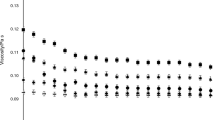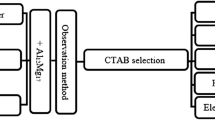Abstract
Particle-stabilized dispersions are considered as potential high-temperature, high-energy–density heat transfer fluids as well as thermal energy storage materials. To be useful practically, these dispersions need to be stable against coalescence and have low viscosity. We present indirect experimental evidence of particle stabilization of Al–Si in NaCl–NaF dispersions with graphite as the stabilizer. We found no evidence of particle stabilization in the same system with boron carbide, silicon carbide, silica, or zirconia as the stabilizer. We also present indirect experimental evidence of particle stabilization in Al/B2O3/C and Al/NaCl–KCl/Al2O3 dispersed phase/dispersion media/stabilizer systems.






Similar content being viewed by others
References
US Department of Energy (2012) Multidisciplinary university research initiative: high operating temperature fluids funding opportunity announcement, No. DE-FOA-0000567
Gibbs JP, Hejzlar P, Driscoll MJ (September 15, 2006) Report No.: MIT-GFR-037 applicability of supercritical CO2 power conversion systems to GEN IV reactors
RWE Power (2012) Adele—adiabatic compressed air energy storage for electricity supply. http://www.rwe.com/web/cms/mediablob/en/399030/data/365478/2/rwe/innovation/projects-technologies/energy-storage/project-adele/ADELE-Adiabatic-Compressed-Air-Energy-Storage-for-electricity-supply.pdf. Accessed 30 Oct 2012
HSC Thermochemistry Software Version 5.11 (2010) Outotec
Sze D-K (July 2001) FLINABE, Argonne National Laboratory
Han ZH, Cao FY, Yan B (2008) Appl Phys Lett 92:243104
Pickering SU (1907) J Chem Soc 91:2001
Aveyard R, Binks BP, Clint JH (2003) Adv Coll Interface Sci 100:503
Melle S, Lask M, Fuller GG (2005) Langmuir 21:2158
Banhart J (2006) Adv Eng Mater 8:781
Budai I, Kaptay G (2009) Metall Mater Trans A 40:1524
Budai I, Kaptay G (2011) Intermetallics 19:423
Nagy OZ, Szabo JT, Kaptay G (2012) Intermetallics 26:26
Nakajima T, Nakanishi K, Watanabe N (1976) Bull Chem Soc Jpn 49:994
Nakajima T, Nakanishi K, Watanabe N (1975) Nippon Kagaku Kaishi, p 617
Minami R, Nakajima T, Watanabe N (1975) Nippon Kagaku Kaishi, p 1892
Budai I, Nagy OZ, Kaptay G (2011) Coll Surf A 377:325
Silny A (1996) J Chem Eng Data 41:1340
Roscoe R (1952) Brit J Appl Phys 267:267
Kissa E (1999) Dispersions: characterization, testing, and measurement. Marcel Dekker, New York 173
Madarasz D, Budai I, Kaptay G (2011) Metall Mater Trans A 42:1439
Scheidt RC, Freiling EC (1965) Ion-exchange processes between immiscible molten phases. US Naval Radiological Defense Laboratory, San Francisco
Nakajima T, Nonaka H, Watanabe N (1977) Nippon Kagaku Kaishi, p 959
Binks B, Lumsdon S (2000) Langmuir 16:8622
Kissa E (1999) Dispersions: characterization, testing, and measurement. Marcel Dekker, New York, p 137
Witzke WR (1958) The adhesion of molten boron oxide to various materials. Lewis Flight Propulsion Laboratory, Cleveland
Budai I (2012) Materialwiss Werkstofftech 43:345
Acknowledgements
This study was supported by the US. Department of Energy under Contract No. DE-AC36-08GO28308 to the National Renewable Energy Laboratory.
Author information
Authors and Affiliations
Corresponding author
Electronic supplementary material
Below is the link to the electronic supplementary material.
Rights and permissions
About this article
Cite this article
Starace, A.K., Gomez, J.C. & Glatzmaier, G.C. Can particle-stabilized inorganic dispersions be high-temperature heat-transfer and thermal energy storage fluids?. J Mater Sci 48, 4023–4031 (2013). https://doi.org/10.1007/s10853-013-7214-z
Received:
Accepted:
Published:
Issue Date:
DOI: https://doi.org/10.1007/s10853-013-7214-z




